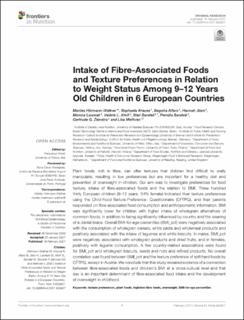Intake of Fibre-Associated Foods and Texture Preferences in Relation to Weight Status Among 9–12 Years Old Children in 6 European Countries
| dc.contributor.author | Hörmann-Wallner, Marlies | |
| dc.contributor.author | Krause, Raphaela | |
| dc.contributor.author | Alfaro, Begoña | |
| dc.contributor.author | Jilani, Hannah | |
| dc.contributor.author | Laureati, Monica | |
| dc.contributor.author | Almli, Valerie Lengard | |
| dc.contributor.author | Sandell, Mari | |
| dc.contributor.author | Sandvik, Pernilla | |
| dc.contributor.author | Zeinstra, Gertrude G. | |
| dc.contributor.author | Methven, Lisa | |
| dc.date.accessioned | 2021-04-21T08:25:02Z | |
| dc.date.available | 2021-04-21T08:25:02Z | |
| dc.date.created | 2021-04-15T13:56:54Z | |
| dc.date.issued | 2021 | |
| dc.identifier.citation | Frontiers in Nutrition. 2021, 8 . | |
| dc.identifier.issn | 2296-861X | |
| dc.identifier.uri | https://hdl.handle.net/11250/2738782 | |
| dc.description.abstract | Plant foods, rich in fibre, can offer textures that children find difficult to orally manipulate, resulting in low preferences but are important for a healthy diet and prevention of overweight in children. Our aim was to investigate preferences for food texture, intake of fibre-associated foods and the relation to BMI. Three hundred thirty European children (9–12 years, 54% female) indicated their texture preferences using the Child-Food-Texture-Preference- Questionnaire (CFTPQ), and their parents responded on fibre-associated food consumption and anthropometric information. BMI was significantly lower for children with higher intake of wholegrain alternatives of common foods; in addition to being significantly influenced by country and the wearing of a dental brace. Overall BMI-for-age-percentiles (BMI_pct) were negatively associated with the consumption of wholegrain cereals, white pasta and wholemeal products and positively associated with the intake of legumes and white biscuits. In males, BMI_pct were negatively associated with wholegrain products and dried fruits, and in females, positively with legume consumption. A few country-related associations were found for BMI_pct and wholegrain biscuits, seeds and nuts and refined products. No overall correlation was found between BMI_pct and the texture preference of soft/hard foods by CFTPQ, except in Austria.We conclude that this study revealed evidence of a connection between fibre-associated foods and children‘s BMI at a cross-cultural level and that sex is an important determinant of fibre-associated food intake and the development of overweight in childhood. | |
| dc.language.iso | eng | |
| dc.subject | Texture preferences | |
| dc.subject | Texture preferences | |
| dc.subject | Overvekt | |
| dc.subject | Overweight | |
| dc.subject | High low fibre foods | |
| dc.subject | High/low fibre foods | |
| dc.subject | Plant foods | |
| dc.subject | Plant foods | |
| dc.title | Intake of Fibre-Associated Foods and Texture Preferences in Relation to Weight Status Among 9–12 Years Old Children in 6 European Countries | |
| dc.type | Peer reviewed | |
| dc.type | Journal article | |
| dc.description.version | publishedVersion | |
| dc.source.pagenumber | 13 | |
| dc.source.volume | 8 | |
| dc.source.journal | Frontiers in Nutrition | |
| dc.identifier.doi | 10.3389/fnut.2021.633807 | |
| dc.identifier.cristin | 1904320 | |
| dc.relation.project | Norges forskningsråd: 314318 | |
| dc.relation.project | Nofima AS: 202103 | |
| dc.relation.project | Norges forskningsråd: 233831 | |
| dc.relation.project | Nofima AS: 10862 | |
| cristin.ispublished | true | |
| cristin.fulltext | original | |
| cristin.qualitycode | 1 |
Tilhørende fil(er)
Denne innførselen finnes i følgende samling(er)
-
Artikler / Articles [1419]
-
Publikasjoner fra CRIStin [2481]
